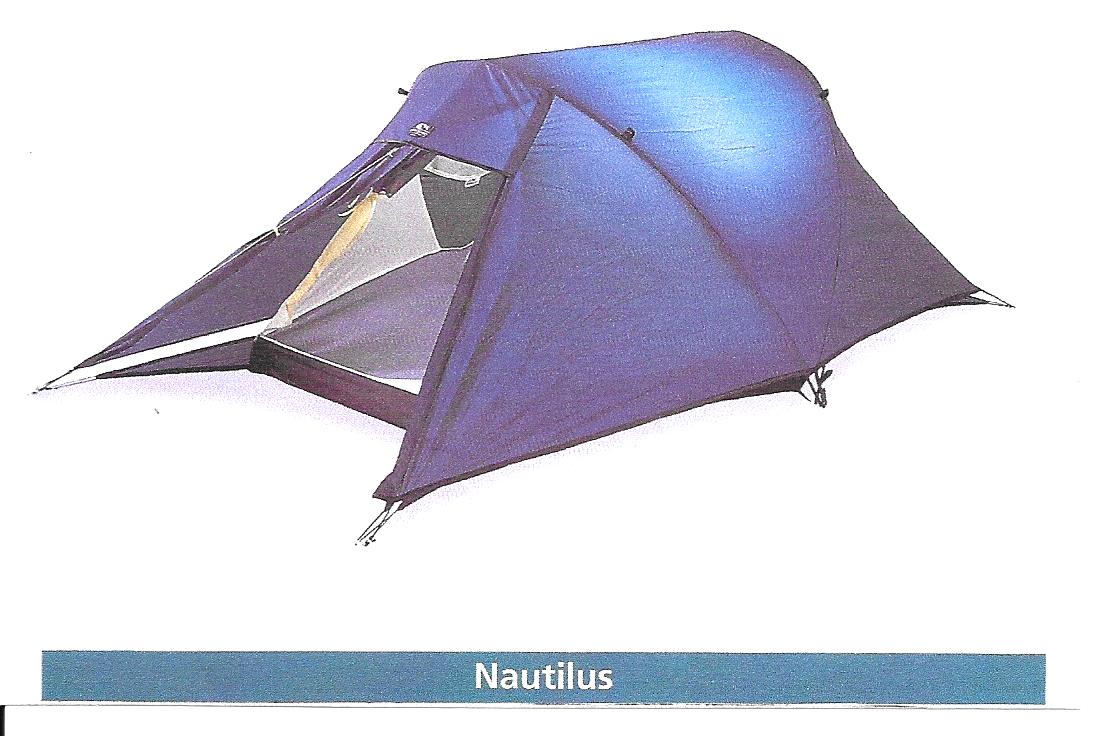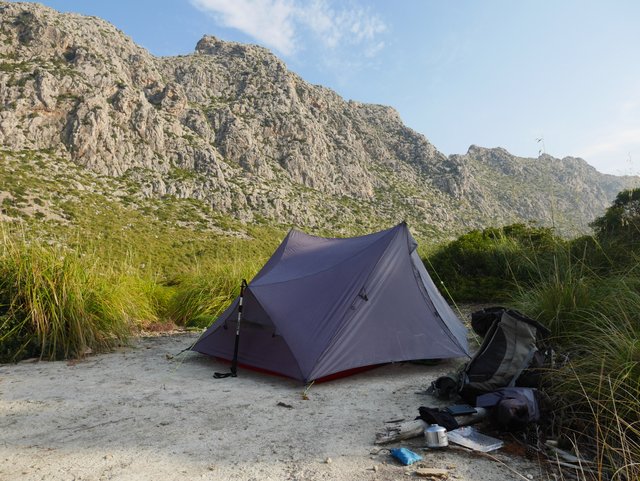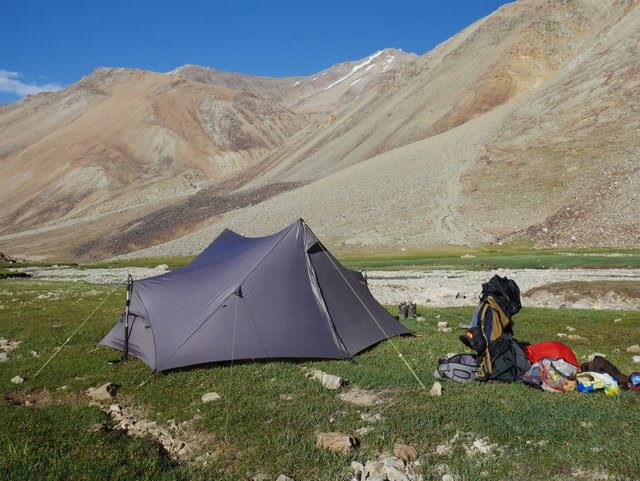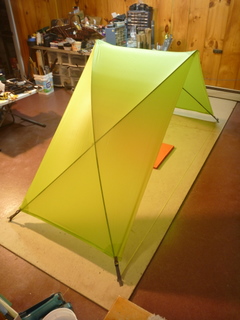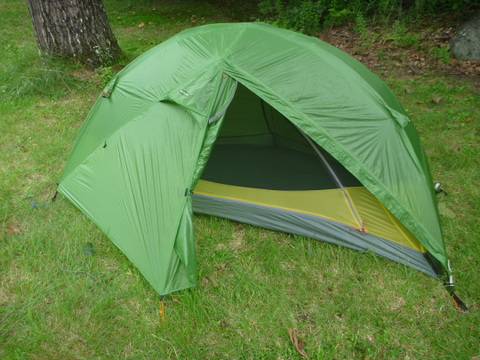Topic
MYOG 2P Trekking pole supported tent for more demanding conditions
Forum Posting
A Membership is required to post in the forums. Login or become a member to post in the member forums!
Home › Forums › Gear Forums › Make Your Own Gear › MYOG 2P Trekking pole supported tent for more demanding conditions
- This topic has 35 replies, 14 voices, and was last updated 5 years, 10 months ago by
 Gunnar H.
Gunnar H.
-
AuthorPosts
-
Mar 26, 2019 at 2:49 am #3585504
Roger,
Thank you for that elaboration. I think it means that the shockcord must only be used on the side of the tent that is facing downwind.A consequence is that like a tunnel, the tension created by the shockcord must reduce the amount of sag (when conditions create sag) for the whole tent, including the side where the stakepoints are held securely in place.
Since I have decided to enlarge the windward and downwind side of the tent, the footprint will now be an equal sided hexagon. Didn’t want to do this, because it precludes use of smaller sites in which to pitch; but wanted the vestibules to project enough to provide more leverage for the stakepoints, as illustrated by this Macpac tent:

Since it will be only a solo tent, I don’t think the larger footprint will make it difficult to find places in which to pitch. Since wind resistance is a prime consideration, much of the pitching will more likely be in open areas, whether above or below timberline. This is a change from my usual practice of descending to lower altitude to find more protected areas for pitching.
As as been mentioned, wind direction can shift, especially in mountainous areas. That is the reason the roof over the sides of the tent where the poles are anchored will be gothic arched rather than hooped, and canted at a greater angle than the Macpac tent in order to reduce wind resistance.
In your scenario, a full 180 degree wind shift could demolish the tent. Should have paid more attention over the years to how often the wind does a 180, or even a 90. May need to add 2 pegs at the two points where the poles come together and are anchored.
On a related note, RBTR’s product description of the 20 D, 1.1 oz sil/polyester XL used by the OP includes the following: “Designed from the ground up by us, the custom woven XL width and enhanced waterproof coating combine to offer best in-class coverage and protection from the elements.” (The HH before aging is spec’d at 2500mm, but specifics regarding durability. have yet to be added to RBTR’s FAQ section.
Mar 26, 2019 at 2:59 am #3585507Hi Sam
I think it means that the shockcord must only be used on the side of the tent that is facing downwind.
Absolutely!In your scenario, a full 180 degree wind shift could demolish the tent. Should have paid more attention over the years to how often the wind does a 180, or even a 90.
Such a shift could be very embarrassing!
Fwiiw, I do also have cord loops in parallel with the bungee cord loops, to handle that problem. However, given Australian and European weather, I have never had to use them. Our winds do not swing round 180 degrees, or even 90 degrees.Ah – I had better mention one time long ago when I foolishly pitched my tent right behind a very large rock, which was meant to act as a wind break. It didn’t; rather the rock shed vortices all night long from all directions. The tent was hit by wind from all 5 different directions! (The 5th was straight downwards.) We had a disturbed night. These days I pitch just downwind of a copse of trees, or deep inside the forest. That always works.
Cheers
Mar 26, 2019 at 3:29 am #3585511We can often find giant rocks in northern NH, including forested areas. Ledges also. Some have become well known picnic spots. A giant rock, several stories high and just sitting in the woods, seems to garner a lot of attention: https://goo.gl/images/oR9vQJ
There was a Public Broadcasting show about a much larger rock in Australia, and its religious significance to native peoples.
Mar 26, 2019 at 3:32 am #3585513I was thinking of something a shade smaller than that!
Cheers
Mar 28, 2019 at 2:54 pm #3585927@Sam: comparing 40D silnylon and 20D Silpoly I have on 2 shelters, Silnylon has maybe 2x higher crosswise stretch. That is one of the reasons that even with somewhat reduced centenary cuts on Silpoly shelter, the pitch is very tight. I agree that higher stretch can be an advantage for wind force dissipation. I think Silpoly is strong enough in terms of tear strength. When you take a strip of fabric, It is very difficult to tear it. The question of deterioration in HH of this particular fabric is another matter – to be proven over time. I chose no sag over higher force dissipation properties and tear strength. I am not convinced that bungee cords would address the sag on my shelter as Silpoly does.
Mar 28, 2019 at 8:37 pm #3585974Hi Milan
A photo of your shelter in action would be useful.
Cheers
Apr 1, 2019 at 5:00 pm #3586530Hello Roger, I was referring to tent in my post. Nevertheless, here are 2 pictures of my tent in action. A bit more relaxed and lose pitch during Mallorca traverse and tight and low pitch on TJ trek, where glacial winds down the valley were a concern.

 Apr 1, 2019 at 8:43 pm #3586564
Apr 1, 2019 at 8:43 pm #3586564@Milan: two very nice photos of a well-made tent. The scenery does not hurt of course. Well done.
Cheers
Apr 2, 2019 at 5:02 am #3586641Milan,
20D silnylon is available at Extrem Textil in Germany: https://www.extremtextil.de/en/ripstop-nylon-tentfabric-silicone-coated-20den-36g-sqm.htmlBut agree that polyester is better at reducing sag than silnylon. This is apparent from the photos showing how tautly your tent pitches. There are ways, however, to reduce sag on nylon. One method is to design the tent so that the main part of the canopy is always kept stretched diagonally to the warp and weft, or grain, of the fabric, often referred to bias stretch, which is greater for nylon. This is illustrated on a prototype silnylon canopy:

Another method is to use the 7-15D nylons that are coated with both sil and PU, one on each side of the fabric. The 7D is available from Rockywoods in the USA; but I have had to harvest the 15D from Sea to Summit tarps. In tests, I’ve found the PU coat on one side also helps to reduce the sag; but again, not as much as using polytester.
A third method is by use of the shockcord to which Roger alluded. Here is a 15D nylon tent using the second and third methods (PU coat and shockcord) to limit sag after a temperature drop and night of cold rain:

The shockcord is not visible in the photo, but it is there at the front stake point. Granted, there is significant wrinkling, but no sagging. When the PU coat and the shockcord are combined with the first method, permanent bias stretch, I believe the wrinkling can be eliminated.
The reason for all this is to obtain the strength of nylon, and therefore to achieve lighter weight, without incurring the sag on the canopy.. And that is why the choice between nylon and polyester can be so difficult. There was even a thread on BPL about using the Rockywoods 7D nylon for floors, something that IMO would be ridiculous for a 7D polyester.
Having said all that, please accept my admiration for the drum tight canopy you have achieved on your tent, partly by using 20D polyester. As you state, the 20D will certainly hold up well with the usual reinforcements at stress points, such as guy and stake points..
Apr 2, 2019 at 6:14 am #3586648Thanks both of you for your kind words.
@Sam: Yes, I was considering 20D Silnylon from Extremtextil for my first pyramid tent, but it tested quite poorly in Richard Nisley ageing test. I also contacted a BPL member (Kai Harris) who built his tent out of it. Finally I decided to go for 40D Silnylon for a pyramid. Whether the coating improved since I do not know. Based on that experience and significant sag with 40D I opted for Silpoly later.Thanks for the detailed explanation about “tight pitch” possibilities with either material and method, much appreciated. I agree that Nylon with Si/Pu coating can be a viable and light option. In the end, for 98% of encountered conditions, either material shall do just fine if the design is good and the user understands the limits of his UL shelter.
Apr 2, 2019 at 11:11 am #3586653However, given Australian and European weather, I have never had to use them. Our winds do not swing round 180 degrees, or even 90 degrees.
A little thread drift, but information giving a bit more detail is always welcome at BPL?
In Scandinavia (in Northern Europe) it is common to have a wind shift of about 90 degrees overnight as weather systems from the Atlantic, advances typically moving towards east-northeast as a system. I would think this should apply to Scotland and large parts and England as well as being part of the same weather pattern, but doesn´t usually apply to other parts of Europe.

-
AuthorPosts
- You must be logged in to reply to this topic.
Forum Posting
A Membership is required to post in the forums. Login or become a member to post in the member forums!
HAPPENING RIGHT NOW (February 11-21, 2025) - Shop Hyperlite Mountain Gear's Biggest Sale of the Year:
Our Community Posts are Moderated
Backpacking Light community posts are moderated and here to foster helpful and positive discussions about lightweight backpacking. Please be mindful of our values and boundaries and review our Community Guidelines prior to posting.
Get the Newsletter
Gear Research & Discovery Tools
- Browse our curated Gear Shop
- See the latest Gear Deals and Sales
- Our Recommendations
- Search for Gear on Sale with the Gear Finder
- Used Gear Swap
- Member Gear Reviews and BPL Gear Review Articles
- Browse by Gear Type or Brand.

